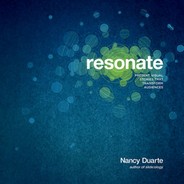16 Resonate
Ever since humans first sat around the campfire, sto-
ries have been told to create emotional connections.
In many societies, they have been passed along nearly
unchanged for generations. The greatest stories of
all time were packaged and transferred so well that
hundreds of illiterate generations could repeat them.
Our early ancestors had stories to explain day-to-day
occurrences in nature such as why the sun rises and
falls, as well as more overarching metanarratives about
the meaning of life. Stories are the most powerful deliv-
ery tool for information, more powerful and enduring
than any other art form.
People love stories because life is full of adventure
and we’re hardwired to learn lessons from observing
change in others. Life is messy, so we empathize with
characters who have real-life challenges similar to the
ones we face. When we listen to a story, the chemicals
in our body change, and our mind becomes transfixed.
5
We are riveted when a character encounters a situation
that involves risks and elated when he averts danger
and is rewarded.
If you’re like many professionals, using stories to create
emotional appeal feels unnatural because it requires
showing at least some degree of vulnerability to people
you don’t personally know all that well. Telling a per-
sonal story can be especially daunting because great
personal stories have a conflict or complication that
Stories Convey Meaning
exposes your humanness or flaws. But these are also
the stories that have the most inherent power to change
others. People enjoy following a leader who has sur-
vived personal challenges and can share her narrative
of struggle and victory (or defeat) comfortably.
“The best way to unite an idea with an emotion is by
telling a compelling story. In a story, you not only
weave a lot of information into the telling but you also
arouse your listener’s emotions and energy. Persuading
with a story is hard. Any intelligent person can sit down
and make lists. It takes rationality but little creativity to
design an argument using conventional rhetoric. But it
demands vivid insight and storytelling skill to present
an idea that packs enough emotional power to be
memorable. If you can harness imagination and the
principles of a well-told story, then you get people
rising to their feet amid thunderous applause instead
of yawning and ignoring you.”
Robert McKee
6
Information is static; stories are dynamic—they help an
audience visualize what you do or what you believe. Tell
a story and people will be more engaged and receptive
to the ideas you are communicating. Stories link one
person’s heart to another. Values, beliefs, and norms
become intertwined. When this happens, your idea can
more readily manifest as reality in their minds.
CH001.indd 16CH001.indd 16 8/17/10 4:11:48 PM8/17/10 4:11:48 PM

Why Resonate? 17
CH001.indd 17CH001.indd 17 8/17/10 4:11:48 PM8/17/10 4:11:48 PM
..................Content has been hidden....................
You can't read the all page of ebook, please click here login for view all page.
